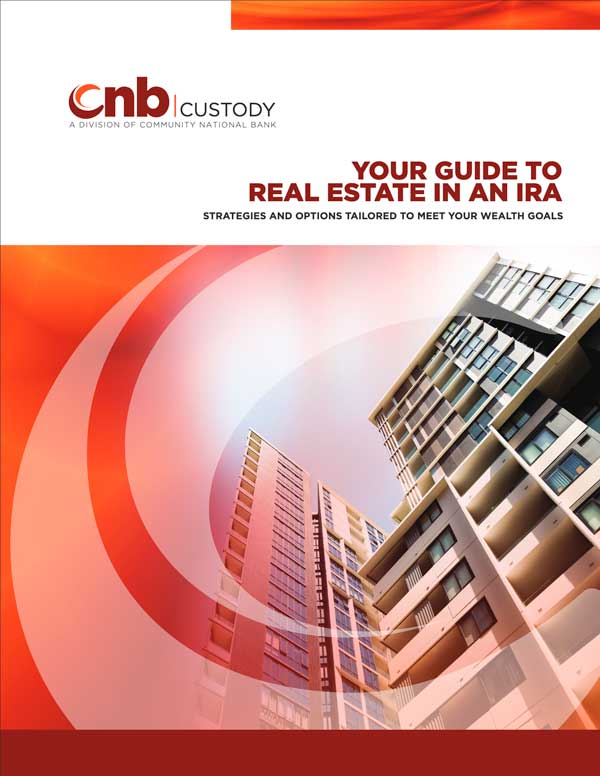
Real Estate Investing Within a Self-Directed IRA
Real Estate Investing Within a Self-Directed IRA
Real estate is a popular retirement investment among self-directed IRA investors. Some of the benefits include: owning a tangible asset that can produce a steady income, potential for the investment to appreciate in value, and providing another option for building a balanced and diversified portfolio. Another reason for the rising popularity of real estate investments is it’s a time-tested hedge against inflation.
Earnings and appreciation from real estate property are tax-deferred if held in a traditional IRA and have the potential to be tax-free if held in a Roth IRA.
Real estate investing also offers multiple investment strategies, including “buy-and-hold” or “flip-and-sell.” In addition, there are multiple options for funding your real estate investment. This includes direct purchases, partnering with other investors, and leveraging with a non-recourse loan.
Before investing, it is also important to know the risks and potential pitfalls of owning real estate within an IRA. Speak with an attorney, tax accountant, or investment professional before investing. Review the guidelines and prohibited transaction information available in our real estate guide and Internal Revenue Code (IRC) 4975.
Real Estate Options Your IRA Can Own
- Residential real estate, such as single or multifamily properties, condos, and apartments
- Commercial real estate, such as office buildings, retail shops, and convenience stores
- Farms
- Resort property
- Vacant land
- Trust deeds
- Mortgage notes
- Single Member LLCs
IRA Restrictions
It's important to understand all the rules governing IRA investments. The IRS requires IRA real estate to be for investment purposes only and has rules regarding how the real estate can be purchased and used. IRC 4975 also provides a list of disqualified persons that your IRA cannot transact with. It is important to understand these rules and the IRS definition of the term “disqualified persons.”
Disqualified persons: These are people who cannot benefit from the property owned by the self-directed IRA. This includes the account holder, his or her parents, grandparents, spouse, children and grandchildren and their spouses, and great-grandparents and great-grandchildren. These are called “lineal ascendants and descendants.” For example, you cannot rent a flower shop owned by your IRA to your child. See IRC 4975 for a full list of disqualified persons.
Prohibited transactions: A self-directed IRA cannot own any property that is used for the personal benefit of the account holder or any disqualified person. For example, you cannot run your business out of a building owned by your IRA or live in a house owned by your IRA. If an IRA owner engages the IRA into these types of transactions, it could lead to a disqualification of the IRA and an immediate distribution of the entire account with possible taxes and penalties incurred.
Prohibited transactions may also include:
- The account holder acting as property manager. All rents must be paid directly to the IRA and not the account holder.
- Expenses – All expenses related to the property must be paid from the IRA.
- Repairs and Maintenance – The account holder or any disqualified person, such as a child, cannot perform any repair or maintenance work on the property. This type of work must be done by a third party and services paid by the IRA.
- Purchases and Sales – The account holder cannot buy or sell property to or from the IRA. Properties held in an IRA cannot be purchased from or sold to a disqualified person.
- Use of Property – Disqualified persons may not live in, rent, or use in any way property owned by the account holder’s IRA.
- Please see IRC 4975 for a complete list.
Six Steps to Self-Directed IRA Real Estate Investing
Our experienced staff will work closely with you by providing educational resources to assist you with the rules for real estate investing. CNB has the expertise to help guide you, answer any questions, and make the process easy. You can be assured that your calls and emails will be answered promptly and you’ll receive the attention you deserve every step of the way.
There are four ways you can fund your self-directed IRA:
Transfer funds from an IRA you have with another custodian.
Simply fill out our transfer request form to get started. Transfers do not prompt IRS reporting, taxes, or penalties because they are not considered taxable events.Rollover from another IRA custodian.
Your current custodian will send funds directly to you as account owner. You have 60 days from receipt of the funds to roll them over to another IRA and avoid taxes and penalties on the distribution. This is considered an indirect rollover and is reported to the IRS on Form 5498 since the initial transaction is a distribution. Only one indirect rollover is allowed per 12-month period.Rollover from a 401(k), 403(b), governmental 457(b) account, or other qualified plan.
These are considered direct rollovers and are not reported to the IRS. You will be required to contact your employer’s plan provider with instructions to begin the rollover. We will provide you with our rollover deposit statement.Contribution
Simply complete our contribution form and return it with the amount you would like to invest.Check with your tax advisor to be sure you are eligible for a contribution and the amount you are eligible to make. The standard contribution limit for 2020 is $6,000 or $7,000 if you are 50 or older.
Investment Goals
Rental properties could provide a steady revenue stream. If you prefer asset appreciation, vacant land that is prime for development might be more attractive.Investment Funds
The amount of money you are willing to invest will play a role in the number of options you will have to consider. Property purchase prices will hinge on the local real estate market. You can always partner with others or get a non-recourse loan to help you reach your goals.Expert Assistance
Having a team of experts to step you through the process of real estate investing is crucial. Some professionals to seek out include a financial advisor, a CPA or tax accountant, an attorney to assist with contract issues, a realtor, a lender specializing in non-recourse loans, a property manager, and an IRA custodian.
There are several options available for funding your real estate purchase. These include:
Direct Purchase
Using liquid funds in your IRA, you can buy property quickly and easily. Your IRA pays cash for the property and holds the title.Partner
You can combine your IRA funds with another person’s IRA or personal funds, with another IRA you own (such as using a Roth and traditional), or with your own personal funds. Partnering with yourself or a disqualified person must be done at the time of the original purchase. This will allow you to divide the investment expenses and earnings according to each contributor’s investment amount.Non-Recourse Loan
Allows you to borrow money to purchase a property. Not all banks and credit unions offer these loans. If you are interested in a non-recourse loan, work with your attorney or real estate agent to locate a company that provides these types of loans.
When you have made a decision and are ready to make your real estate investment, simply contact CNB. Our experts will help get you started and answer any questions you may have.
When the title company is ready to close escrow, you will submit the following to CNB Custody:
Warranty or grant deed
Preliminary title report
Estimated closing cost statement
Loan documents (if applicable)
Get Started With Professional Guidance From the Experts
We have many years of experience with self-directed IRAs and we pride ourselves on delivering outstanding customer service. Give us a call. We’ll be ready to answer any questions you may have.
Download our guide
For answers to questions about real estate options, please visit our FAQ page.
